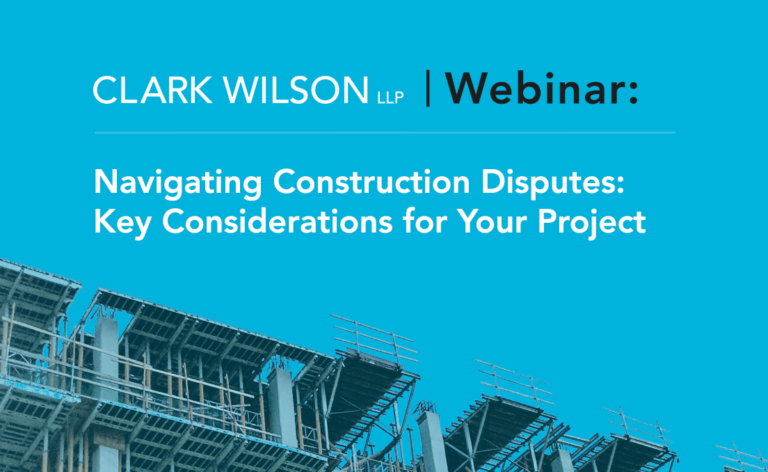
By Scott Lamb and Kim Do
For the first time since 2010, the Canadian Construction Documents Committee (CCDC) updated its construction management contracts: CCDC 5A – Construction Management Contract – For Services, CCDC 5B – Construction Management Contract for Services and Construction, and CCDC 17 – Stipulated Price Contract Between Owner and Trade Contractor for Construction Management Projects. These updates incorporate many modern construction industry practices, legislative changes surrounding prompt payment legislation in other Canadian provinces, evolving project management expectations, and provide greater clarity for owners, construction managers, and trade contractors on project milestones, pre-construction services, fee structures, payment requirements, risk allocation, and overall contract administration.
While these changes may be welcomed by many in the construction industry, undoubtedly owners and contractors will continue to seek adjustments in these standard construction contract forms through supplementary conditions.
We have set out below a summary of some of the key updates and how construction professionals can prepare for these changes.
Key Updates
A. Ready-for-Takeover[1]
A key update in the new CCDC 5A, 5B and 17 is the introduction of the “Ready-for-Takeover” milestone. This expands on a concept previously introduced in the CCDC 2 – 2020 Stipulated Price Contract and redefines how project handover is approached as well as complementing the statutory substantial performance of the work, which remains essential for lien periods and holdback release.
Previously, substantial performance of the work triggered occupancy, warranty commencement, and insurance obligations. Updates to the CCDC contracts now recognize that the statutory definition varies across the provinces and may not align with practical handover needs, often requiring additional deliverables such as as-built drawings or operating manuals to be inserted. The “Ready-for-Takeover” milestone addresses this gap, ensuring the project is ready for operational use, and by integrating “Ready-for-Takeover” alongside substantial performance, these contracts better align legal milestones with practical operational readiness.
“Ready-for-Takeover” is verified by the consultant and will include requirements such as compliance with all occupancy permits and regulatory requirements, final cleaning and removal of debris, delivery of operations and maintenance manuals and as-built documentation, and completion of demonstrations and training for owner personnel.
B. Before Ready-for-Takeover: Early Occupancy[2]
The 2025 updates formalize obtaining “early occupancy”, enabling an owner to take possession of part or all of the project before the “Ready-for-Takeover” milestone. Portions occupied early are considered to have reached “Ready-for-Takeover” and will affect safety responsibilities, warranty periods, and insurance coverage.
Further, early occupancy will require consent from affected trade contractors or the construction manager, along with any necessary approvals from authorities.
C. Pre-Construction Services and Fee Structure[3]
Updates to the CCDC construction management contracts provide clearer treatment of pre-construction services, reflecting the importance of early engagement of construction managers and other construction professionals.
Previously, pre-construction services were included within overall services and compensation but lacked a distinct contractual definition. Now, in the CCDC 5B, “Pre-Construction Services” is a defined category, separate from “Construction Services,” with specific contractual rules. Key updates include a discrete fee model for pre-construction services, payment applications submitted directly to the owner bypassing consultant certification, construction work excluding pre-construction services and reimbursable expenses being limited to pre-construction services.
In the updated CCDC 5A, pre-construction services remain part of overall services but can now be allocated across pre-construction, construction, and post-construction phases. Percentage-based fees are clearly defined for each phase, reducing ambiguity and potential disputes. These changes encourage early engagement in design, budgeting, and review, enhancing project efficiency.
D. Payment Obligations (Prompt Payment) and Progressive Holdback Release[4]
Payment provisions have also been updated in the CCDC contracts to align with prompt payment legislation that have been implemented across multiple Canadian jurisdictions (though not yet in British Columbia). Typically, under prompt payment legislation, construction managers and trade contractors must submit monthly applications for payment, and owners are required to pay within 28 calendar days of receipt, supporting predictable cash flow. Applications must meet the criteria of a proper invoice, ensuring clarity on required documentation.
Further, the progressive release of holdback now applies to all work, including that performed by the construction manager, improving financial predictability and administrative efficiency compared with previous version of the CCDC, which had limited progressive holdback to subcontractors and suppliers.
E. Termination for Convenience and Damages[5]
The new CCDC 5A and 5B now also introduce provisions for termination without cause by owners. Owners may suspend or terminate contracts even if the construction manager is not at fault, providing flexibility to respond to changing project circumstances.
Notably, in the new CCDC 5B, entitlements under termination for convenience are tied to project phases. Specifically, during the pre-construction phase, the construction manager is entitled to a break fee, based on a pre-agreed percentage of the Construction Cost Estimate. During the construction phase, the construction manager may claim direct damages, including reasonable loss of profit.
F. Limitation of Liability[6]
The new CCDC contracts also update limitation of liability provisions. In the CCDC 5A, the cap is the greater of the fee for services or $2 million, up to $20 million. In the updated CCDC 5B and 17, the cap is the greater of the contract price or $2 million, also capped at $20 million.
In the updated CCDCs, a mutual waiver of consequential damages applies, except for fraud, criminal acts, or willful misconduct, providing predictability for financial exposure.
Conclusion and Takeaways
For the purposes of this article, our summary only addresses certain key updates in the CCDC 2025 contracts. Among others, the updated CCDC contracts also provide for other and more practical updates, such as the reorganization of Schedules for Services, Reimbursable Expenses, and Time-Based Rates in the CCDC 5A and 5B. Previously appended to the CCDC contract, these schedules are now provided as separate Word documents.[7]
Overall, the 2025 CCDC updates modernize construction management contracts to better reflect industry practice, legislative developments, and operational realities. By introducing “Ready-for-Takeover”, formalizing early occupancy, clarifying pre-construction fees, aligning with prompt payment legislation, expanding termination causes and clarifying limitations of liability, as summarized above, these contracts offer greater clarity and certainty for owners, construction managers, and trade contractors. Early familiarization with these updates will help construction professionals manage projects more effectively and reduce the risk of disputes.
For example, it will be important for professionals to understand “Ready-for-Takeover” and how this concept differs from substantial performance of the work, as well as to review handover procedures to ensure they align with the verification checklist by the consultant. It will also be important to understand when early occupancy can be obtained. Construction professionals should clarify responsibilities for occupied portions and confirm when warranty periods commence to avoid disputes.
With respect to progressive holdback and payment timelines, construction professionals will want to update internal processes for payment applications and tracking progressive holdback rights.
Owners may suspend or terminate contracts without cause, but will want to review provisions and prepare policies to address break fees and damages depending on the circumstances.
By taking proactive steps to understand and implement these updates, construction professionals can strengthen oversight, reduce administrative burdens, and minimize disputes, ultimately improving project outcomes.
As noted above, many of the changes to the CCDC 5A, 5B and 17 standard contract forms will be welcomed by the construction industry. However, as in the past owners and contractors will continue to need to adjust these contractual terms by way of supplementary conditions in order to tailor the contracts to their needs for the particular projects, the market conditions, and the requirements of the parties to the construction contracts.
Our Construction group has extensive experience dealing with construction management contracts and the negotiation and drafting of supplementary conditions for these contracts. If you have any questions or concerns regarding the review or the preparing of these contracts, or any other construction-related legal.
[1] See provisions in the CCDC 5A at GC 9.1, CCDC 5B at GC 12.1, and CCDC 17 at GC 12.1.
[2] See provisions in the CCDC 5A at GC 9.2, CCDC 5B at GC 12.2, and CCDC 17 at GC 12.2.
[3] See provisions at CCDC 5A at Article A-5 and GC 4.3, and CCDC 5B at Article A-5, Article A-6, and GC 5.3.
[4] See provisions at CCDC 5A at GC 4.2, CCDC 5B at GC 5.3, GC 5.4, GC 5.5, and GC 5.6 and CCDC 17 at GC 5.2, GC 5.3, and GC 5.4.
[5] See provisions at CCDC 5A at GC 6.1, and CCDC 5B at GC 7.1.
[6] See provisions at CCDC 5A at GC 10.2, CCDC 5B at GC 13.2, and CCDC 17 at GC 13.2.
[7] See schedules at CCDC 5A – 2025 Schedule Template (A1, A2, B1, B2 and C) and CCDC 5B – 2025 Schedule Template (A1, A2, B, C and D).




